ALLH12006: Strategies for Evidence-Based Practice in Healthcare Essay
VerifiedAdded on 2022/11/24
|8
|2713
|245
Essay
AI Summary
This essay delves into the critical importance of evidence-based practice (EBP) in healthcare, emphasizing its role in enhancing patient outcomes and fostering a culture of inquiry among clinical practitioners. It outlines the process of EBP implementation, including identifying practice gaps, planning for change, and pinpointing barriers and enablers. The essay further explores the reasons why organizations should promote EBP, such as improving transparency, accountability, and utilizing real-time information. It concludes by detailing specific strategies organizations can employ to support EBP, such as providing resources, mentorship programs, and access to mobile information technologies, ultimately highlighting the transformative impact of EBP on healthcare delivery. This essay is a comprehensive overview of EBP and its significance in modern healthcare.
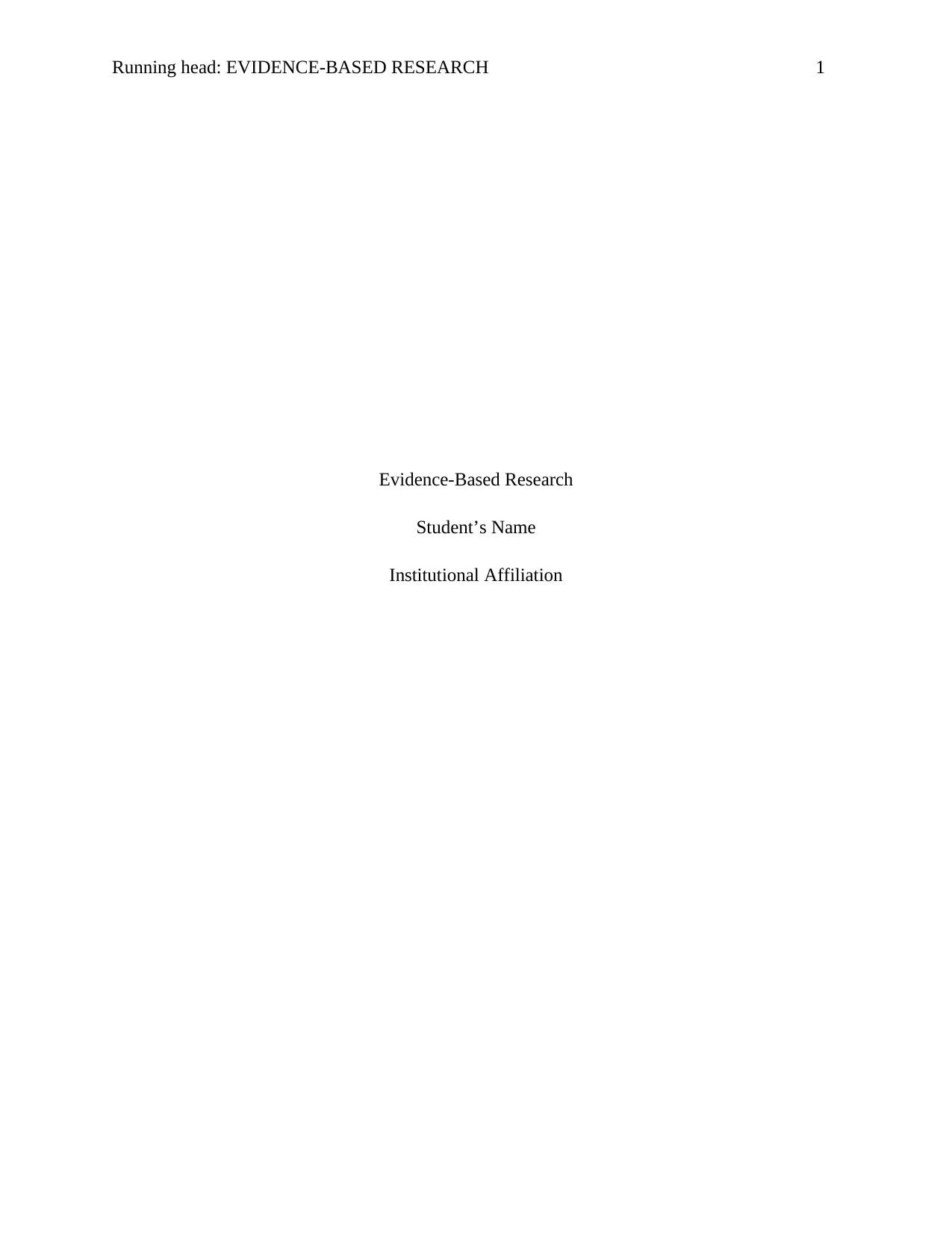
Running head: EVIDENCE-BASED RESEARCH 1
Evidence-Based Research
Student’s Name
Institutional Affiliation
Evidence-Based Research
Student’s Name
Institutional Affiliation
Paraphrase This Document
Need a fresh take? Get an instant paraphrase of this document with our AI Paraphraser
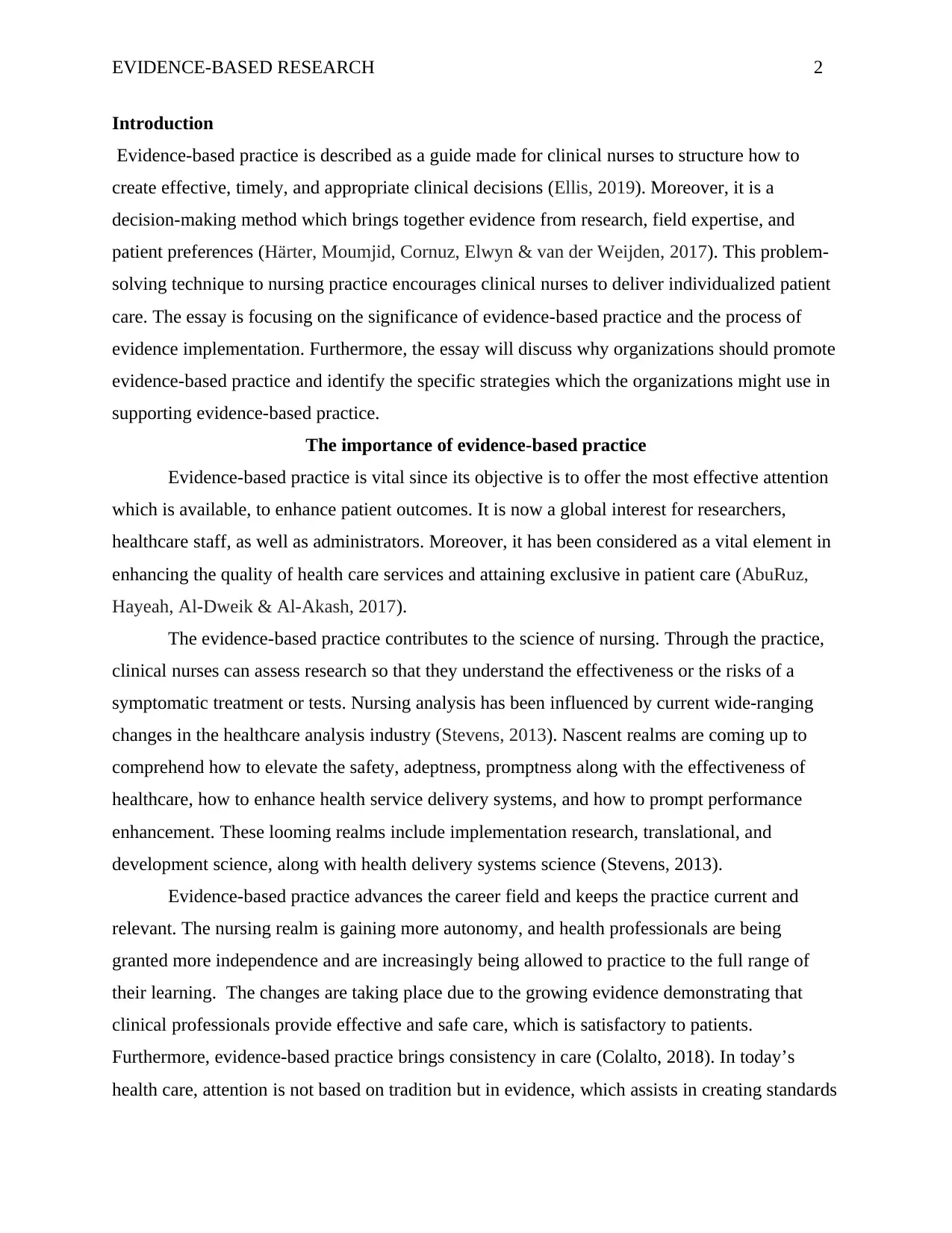
EVIDENCE-BASED RESEARCH 2
Introduction
Evidence-based practice is described as a guide made for clinical nurses to structure how to
create effective, timely, and appropriate clinical decisions (Ellis, 2019). Moreover, it is a
decision-making method which brings together evidence from research, field expertise, and
patient preferences (Härter, Moumjid, Cornuz, Elwyn & van der Weijden, 2017). This problem-
solving technique to nursing practice encourages clinical nurses to deliver individualized patient
care. The essay is focusing on the significance of evidence-based practice and the process of
evidence implementation. Furthermore, the essay will discuss why organizations should promote
evidence-based practice and identify the specific strategies which the organizations might use in
supporting evidence-based practice.
The importance of evidence-based practice
Evidence-based practice is vital since its objective is to offer the most effective attention
which is available, to enhance patient outcomes. It is now a global interest for researchers,
healthcare staff, as well as administrators. Moreover, it has been considered as a vital element in
enhancing the quality of health care services and attaining exclusive in patient care (AbuRuz,
Hayeah, Al-Dweik & Al-Akash, 2017).
The evidence-based practice contributes to the science of nursing. Through the practice,
clinical nurses can assess research so that they understand the effectiveness or the risks of a
symptomatic treatment or tests. Nursing analysis has been influenced by current wide-ranging
changes in the healthcare analysis industry (Stevens, 2013). Nascent realms are coming up to
comprehend how to elevate the safety, adeptness, promptness along with the effectiveness of
healthcare, how to enhance health service delivery systems, and how to prompt performance
enhancement. These looming realms include implementation research, translational, and
development science, along with health delivery systems science (Stevens, 2013).
Evidence-based practice advances the career field and keeps the practice current and
relevant. The nursing realm is gaining more autonomy, and health professionals are being
granted more independence and are increasingly being allowed to practice to the full range of
their learning. The changes are taking place due to the growing evidence demonstrating that
clinical professionals provide effective and safe care, which is satisfactory to patients.
Furthermore, evidence-based practice brings consistency in care (Colalto, 2018). In today’s
health care, attention is not based on tradition but in evidence, which assists in creating standards
Introduction
Evidence-based practice is described as a guide made for clinical nurses to structure how to
create effective, timely, and appropriate clinical decisions (Ellis, 2019). Moreover, it is a
decision-making method which brings together evidence from research, field expertise, and
patient preferences (Härter, Moumjid, Cornuz, Elwyn & van der Weijden, 2017). This problem-
solving technique to nursing practice encourages clinical nurses to deliver individualized patient
care. The essay is focusing on the significance of evidence-based practice and the process of
evidence implementation. Furthermore, the essay will discuss why organizations should promote
evidence-based practice and identify the specific strategies which the organizations might use in
supporting evidence-based practice.
The importance of evidence-based practice
Evidence-based practice is vital since its objective is to offer the most effective attention
which is available, to enhance patient outcomes. It is now a global interest for researchers,
healthcare staff, as well as administrators. Moreover, it has been considered as a vital element in
enhancing the quality of health care services and attaining exclusive in patient care (AbuRuz,
Hayeah, Al-Dweik & Al-Akash, 2017).
The evidence-based practice contributes to the science of nursing. Through the practice,
clinical nurses can assess research so that they understand the effectiveness or the risks of a
symptomatic treatment or tests. Nursing analysis has been influenced by current wide-ranging
changes in the healthcare analysis industry (Stevens, 2013). Nascent realms are coming up to
comprehend how to elevate the safety, adeptness, promptness along with the effectiveness of
healthcare, how to enhance health service delivery systems, and how to prompt performance
enhancement. These looming realms include implementation research, translational, and
development science, along with health delivery systems science (Stevens, 2013).
Evidence-based practice advances the career field and keeps the practice current and
relevant. The nursing realm is gaining more autonomy, and health professionals are being
granted more independence and are increasingly being allowed to practice to the full range of
their learning. The changes are taking place due to the growing evidence demonstrating that
clinical professionals provide effective and safe care, which is satisfactory to patients.
Furthermore, evidence-based practice brings consistency in care (Colalto, 2018). In today’s
health care, attention is not based on tradition but in evidence, which assists in creating standards
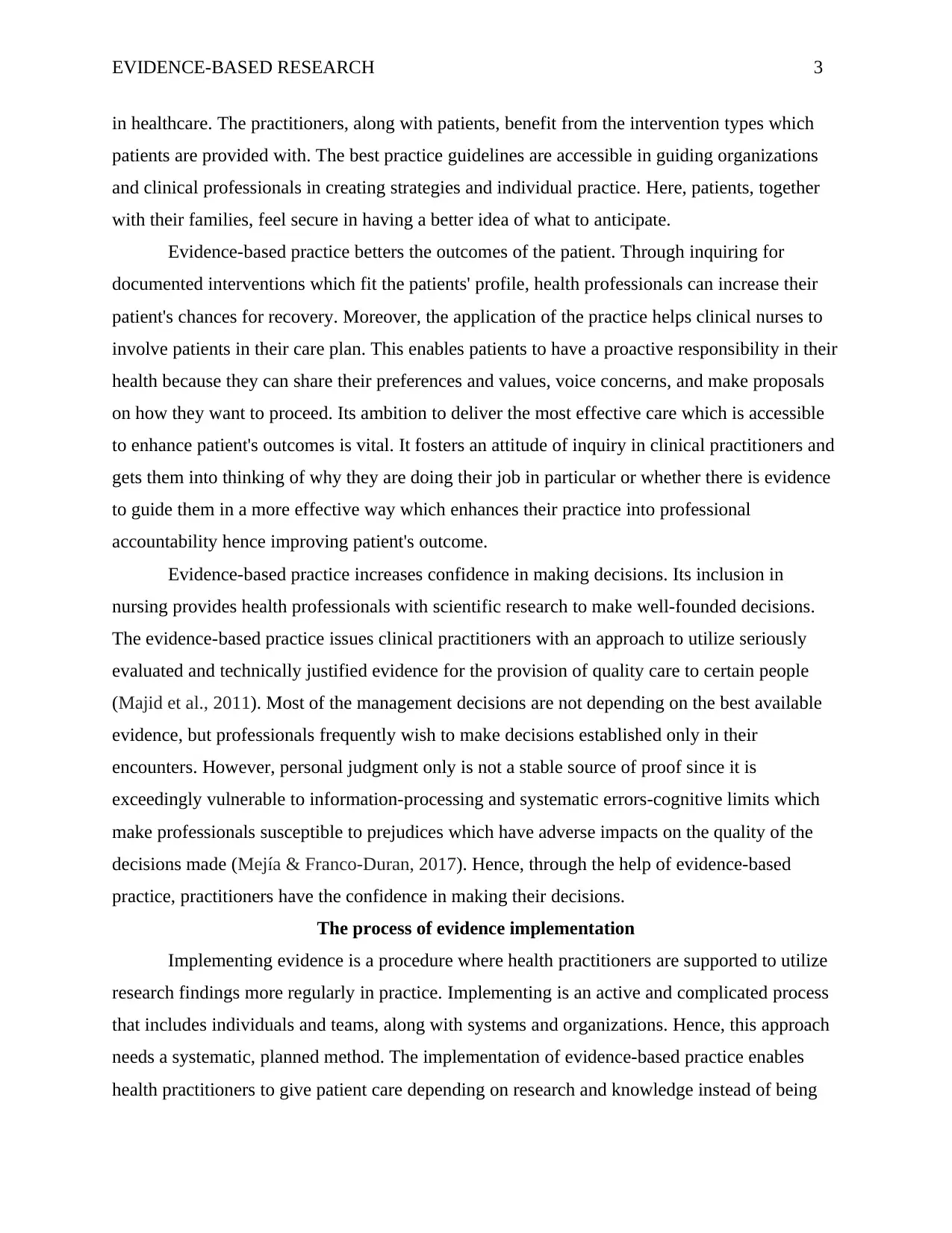
EVIDENCE-BASED RESEARCH 3
in healthcare. The practitioners, along with patients, benefit from the intervention types which
patients are provided with. The best practice guidelines are accessible in guiding organizations
and clinical professionals in creating strategies and individual practice. Here, patients, together
with their families, feel secure in having a better idea of what to anticipate.
Evidence-based practice betters the outcomes of the patient. Through inquiring for
documented interventions which fit the patients' profile, health professionals can increase their
patient's chances for recovery. Moreover, the application of the practice helps clinical nurses to
involve patients in their care plan. This enables patients to have a proactive responsibility in their
health because they can share their preferences and values, voice concerns, and make proposals
on how they want to proceed. Its ambition to deliver the most effective care which is accessible
to enhance patient's outcomes is vital. It fosters an attitude of inquiry in clinical practitioners and
gets them into thinking of why they are doing their job in particular or whether there is evidence
to guide them in a more effective way which enhances their practice into professional
accountability hence improving patient's outcome.
Evidence-based practice increases confidence in making decisions. Its inclusion in
nursing provides health professionals with scientific research to make well-founded decisions.
The evidence-based practice issues clinical practitioners with an approach to utilize seriously
evaluated and technically justified evidence for the provision of quality care to certain people
(Majid et al., 2011). Most of the management decisions are not depending on the best available
evidence, but professionals frequently wish to make decisions established only in their
encounters. However, personal judgment only is not a stable source of proof since it is
exceedingly vulnerable to information-processing and systematic errors-cognitive limits which
make professionals susceptible to prejudices which have adverse impacts on the quality of the
decisions made (Mejía & Franco-Duran, 2017). Hence, through the help of evidence-based
practice, practitioners have the confidence in making their decisions.
The process of evidence implementation
Implementing evidence is a procedure where health practitioners are supported to utilize
research findings more regularly in practice. Implementing is an active and complicated process
that includes individuals and teams, along with systems and organizations. Hence, this approach
needs a systematic, planned method. The implementation of evidence-based practice enables
health practitioners to give patient care depending on research and knowledge instead of being
in healthcare. The practitioners, along with patients, benefit from the intervention types which
patients are provided with. The best practice guidelines are accessible in guiding organizations
and clinical professionals in creating strategies and individual practice. Here, patients, together
with their families, feel secure in having a better idea of what to anticipate.
Evidence-based practice betters the outcomes of the patient. Through inquiring for
documented interventions which fit the patients' profile, health professionals can increase their
patient's chances for recovery. Moreover, the application of the practice helps clinical nurses to
involve patients in their care plan. This enables patients to have a proactive responsibility in their
health because they can share their preferences and values, voice concerns, and make proposals
on how they want to proceed. Its ambition to deliver the most effective care which is accessible
to enhance patient's outcomes is vital. It fosters an attitude of inquiry in clinical practitioners and
gets them into thinking of why they are doing their job in particular or whether there is evidence
to guide them in a more effective way which enhances their practice into professional
accountability hence improving patient's outcome.
Evidence-based practice increases confidence in making decisions. Its inclusion in
nursing provides health professionals with scientific research to make well-founded decisions.
The evidence-based practice issues clinical practitioners with an approach to utilize seriously
evaluated and technically justified evidence for the provision of quality care to certain people
(Majid et al., 2011). Most of the management decisions are not depending on the best available
evidence, but professionals frequently wish to make decisions established only in their
encounters. However, personal judgment only is not a stable source of proof since it is
exceedingly vulnerable to information-processing and systematic errors-cognitive limits which
make professionals susceptible to prejudices which have adverse impacts on the quality of the
decisions made (Mejía & Franco-Duran, 2017). Hence, through the help of evidence-based
practice, practitioners have the confidence in making their decisions.
The process of evidence implementation
Implementing evidence is a procedure where health practitioners are supported to utilize
research findings more regularly in practice. Implementing is an active and complicated process
that includes individuals and teams, along with systems and organizations. Hence, this approach
needs a systematic, planned method. The implementation of evidence-based practice enables
health practitioners to give patient care depending on research and knowledge instead of being
⊘ This is a preview!⊘
Do you want full access?
Subscribe today to unlock all pages.

Trusted by 1+ million students worldwide
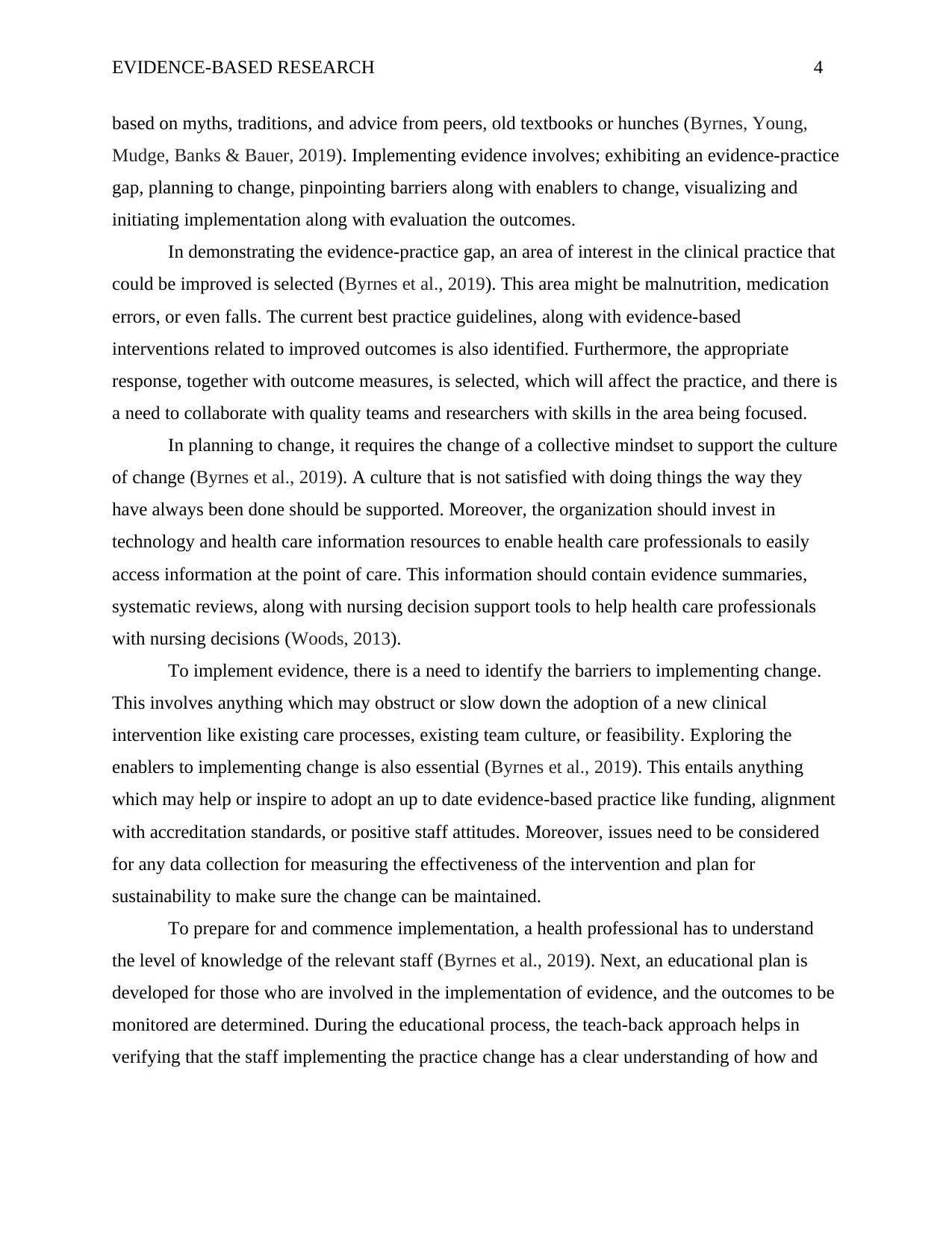
EVIDENCE-BASED RESEARCH 4
based on myths, traditions, and advice from peers, old textbooks or hunches (Byrnes, Young,
Mudge, Banks & Bauer, 2019). Implementing evidence involves; exhibiting an evidence-practice
gap, planning to change, pinpointing barriers along with enablers to change, visualizing and
initiating implementation along with evaluation the outcomes.
In demonstrating the evidence-practice gap, an area of interest in the clinical practice that
could be improved is selected (Byrnes et al., 2019). This area might be malnutrition, medication
errors, or even falls. The current best practice guidelines, along with evidence-based
interventions related to improved outcomes is also identified. Furthermore, the appropriate
response, together with outcome measures, is selected, which will affect the practice, and there is
a need to collaborate with quality teams and researchers with skills in the area being focused.
In planning to change, it requires the change of a collective mindset to support the culture
of change (Byrnes et al., 2019). A culture that is not satisfied with doing things the way they
have always been done should be supported. Moreover, the organization should invest in
technology and health care information resources to enable health care professionals to easily
access information at the point of care. This information should contain evidence summaries,
systematic reviews, along with nursing decision support tools to help health care professionals
with nursing decisions (Woods, 2013).
To implement evidence, there is a need to identify the barriers to implementing change.
This involves anything which may obstruct or slow down the adoption of a new clinical
intervention like existing care processes, existing team culture, or feasibility. Exploring the
enablers to implementing change is also essential (Byrnes et al., 2019). This entails anything
which may help or inspire to adopt an up to date evidence-based practice like funding, alignment
with accreditation standards, or positive staff attitudes. Moreover, issues need to be considered
for any data collection for measuring the effectiveness of the intervention and plan for
sustainability to make sure the change can be maintained.
To prepare for and commence implementation, a health professional has to understand
the level of knowledge of the relevant staff (Byrnes et al., 2019). Next, an educational plan is
developed for those who are involved in the implementation of evidence, and the outcomes to be
monitored are determined. During the educational process, the teach-back approach helps in
verifying that the staff implementing the practice change has a clear understanding of how and
based on myths, traditions, and advice from peers, old textbooks or hunches (Byrnes, Young,
Mudge, Banks & Bauer, 2019). Implementing evidence involves; exhibiting an evidence-practice
gap, planning to change, pinpointing barriers along with enablers to change, visualizing and
initiating implementation along with evaluation the outcomes.
In demonstrating the evidence-practice gap, an area of interest in the clinical practice that
could be improved is selected (Byrnes et al., 2019). This area might be malnutrition, medication
errors, or even falls. The current best practice guidelines, along with evidence-based
interventions related to improved outcomes is also identified. Furthermore, the appropriate
response, together with outcome measures, is selected, which will affect the practice, and there is
a need to collaborate with quality teams and researchers with skills in the area being focused.
In planning to change, it requires the change of a collective mindset to support the culture
of change (Byrnes et al., 2019). A culture that is not satisfied with doing things the way they
have always been done should be supported. Moreover, the organization should invest in
technology and health care information resources to enable health care professionals to easily
access information at the point of care. This information should contain evidence summaries,
systematic reviews, along with nursing decision support tools to help health care professionals
with nursing decisions (Woods, 2013).
To implement evidence, there is a need to identify the barriers to implementing change.
This involves anything which may obstruct or slow down the adoption of a new clinical
intervention like existing care processes, existing team culture, or feasibility. Exploring the
enablers to implementing change is also essential (Byrnes et al., 2019). This entails anything
which may help or inspire to adopt an up to date evidence-based practice like funding, alignment
with accreditation standards, or positive staff attitudes. Moreover, issues need to be considered
for any data collection for measuring the effectiveness of the intervention and plan for
sustainability to make sure the change can be maintained.
To prepare for and commence implementation, a health professional has to understand
the level of knowledge of the relevant staff (Byrnes et al., 2019). Next, an educational plan is
developed for those who are involved in the implementation of evidence, and the outcomes to be
monitored are determined. During the educational process, the teach-back approach helps in
verifying that the staff implementing the practice change has a clear understanding of how and
Paraphrase This Document
Need a fresh take? Get an instant paraphrase of this document with our AI Paraphraser
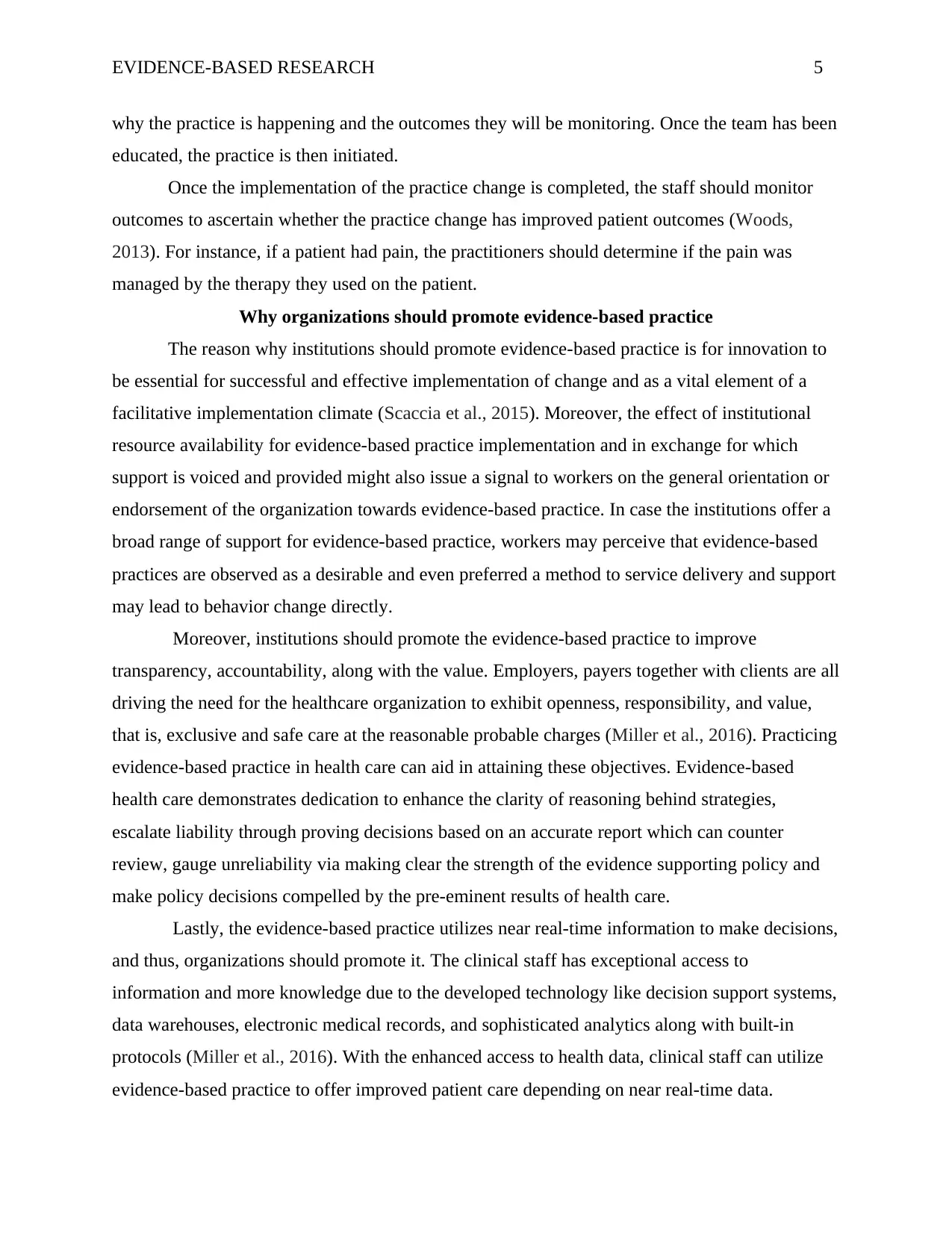
EVIDENCE-BASED RESEARCH 5
why the practice is happening and the outcomes they will be monitoring. Once the team has been
educated, the practice is then initiated.
Once the implementation of the practice change is completed, the staff should monitor
outcomes to ascertain whether the practice change has improved patient outcomes (Woods,
2013). For instance, if a patient had pain, the practitioners should determine if the pain was
managed by the therapy they used on the patient.
Why organizations should promote evidence-based practice
The reason why institutions should promote evidence-based practice is for innovation to
be essential for successful and effective implementation of change and as a vital element of a
facilitative implementation climate (Scaccia et al., 2015). Moreover, the effect of institutional
resource availability for evidence-based practice implementation and in exchange for which
support is voiced and provided might also issue a signal to workers on the general orientation or
endorsement of the organization towards evidence-based practice. In case the institutions offer a
broad range of support for evidence-based practice, workers may perceive that evidence-based
practices are observed as a desirable and even preferred a method to service delivery and support
may lead to behavior change directly.
Moreover, institutions should promote the evidence-based practice to improve
transparency, accountability, along with the value. Employers, payers together with clients are all
driving the need for the healthcare organization to exhibit openness, responsibility, and value,
that is, exclusive and safe care at the reasonable probable charges (Miller et al., 2016). Practicing
evidence-based practice in health care can aid in attaining these objectives. Evidence-based
health care demonstrates dedication to enhance the clarity of reasoning behind strategies,
escalate liability through proving decisions based on an accurate report which can counter
review, gauge unreliability via making clear the strength of the evidence supporting policy and
make policy decisions compelled by the pre-eminent results of health care.
Lastly, the evidence-based practice utilizes near real-time information to make decisions,
and thus, organizations should promote it. The clinical staff has exceptional access to
information and more knowledge due to the developed technology like decision support systems,
data warehouses, electronic medical records, and sophisticated analytics along with built-in
protocols (Miller et al., 2016). With the enhanced access to health data, clinical staff can utilize
evidence-based practice to offer improved patient care depending on near real-time data.
why the practice is happening and the outcomes they will be monitoring. Once the team has been
educated, the practice is then initiated.
Once the implementation of the practice change is completed, the staff should monitor
outcomes to ascertain whether the practice change has improved patient outcomes (Woods,
2013). For instance, if a patient had pain, the practitioners should determine if the pain was
managed by the therapy they used on the patient.
Why organizations should promote evidence-based practice
The reason why institutions should promote evidence-based practice is for innovation to
be essential for successful and effective implementation of change and as a vital element of a
facilitative implementation climate (Scaccia et al., 2015). Moreover, the effect of institutional
resource availability for evidence-based practice implementation and in exchange for which
support is voiced and provided might also issue a signal to workers on the general orientation or
endorsement of the organization towards evidence-based practice. In case the institutions offer a
broad range of support for evidence-based practice, workers may perceive that evidence-based
practices are observed as a desirable and even preferred a method to service delivery and support
may lead to behavior change directly.
Moreover, institutions should promote the evidence-based practice to improve
transparency, accountability, along with the value. Employers, payers together with clients are all
driving the need for the healthcare organization to exhibit openness, responsibility, and value,
that is, exclusive and safe care at the reasonable probable charges (Miller et al., 2016). Practicing
evidence-based practice in health care can aid in attaining these objectives. Evidence-based
health care demonstrates dedication to enhance the clarity of reasoning behind strategies,
escalate liability through proving decisions based on an accurate report which can counter
review, gauge unreliability via making clear the strength of the evidence supporting policy and
make policy decisions compelled by the pre-eminent results of health care.
Lastly, the evidence-based practice utilizes near real-time information to make decisions,
and thus, organizations should promote it. The clinical staff has exceptional access to
information and more knowledge due to the developed technology like decision support systems,
data warehouses, electronic medical records, and sophisticated analytics along with built-in
protocols (Miller et al., 2016). With the enhanced access to health data, clinical staff can utilize
evidence-based practice to offer improved patient care depending on near real-time data.
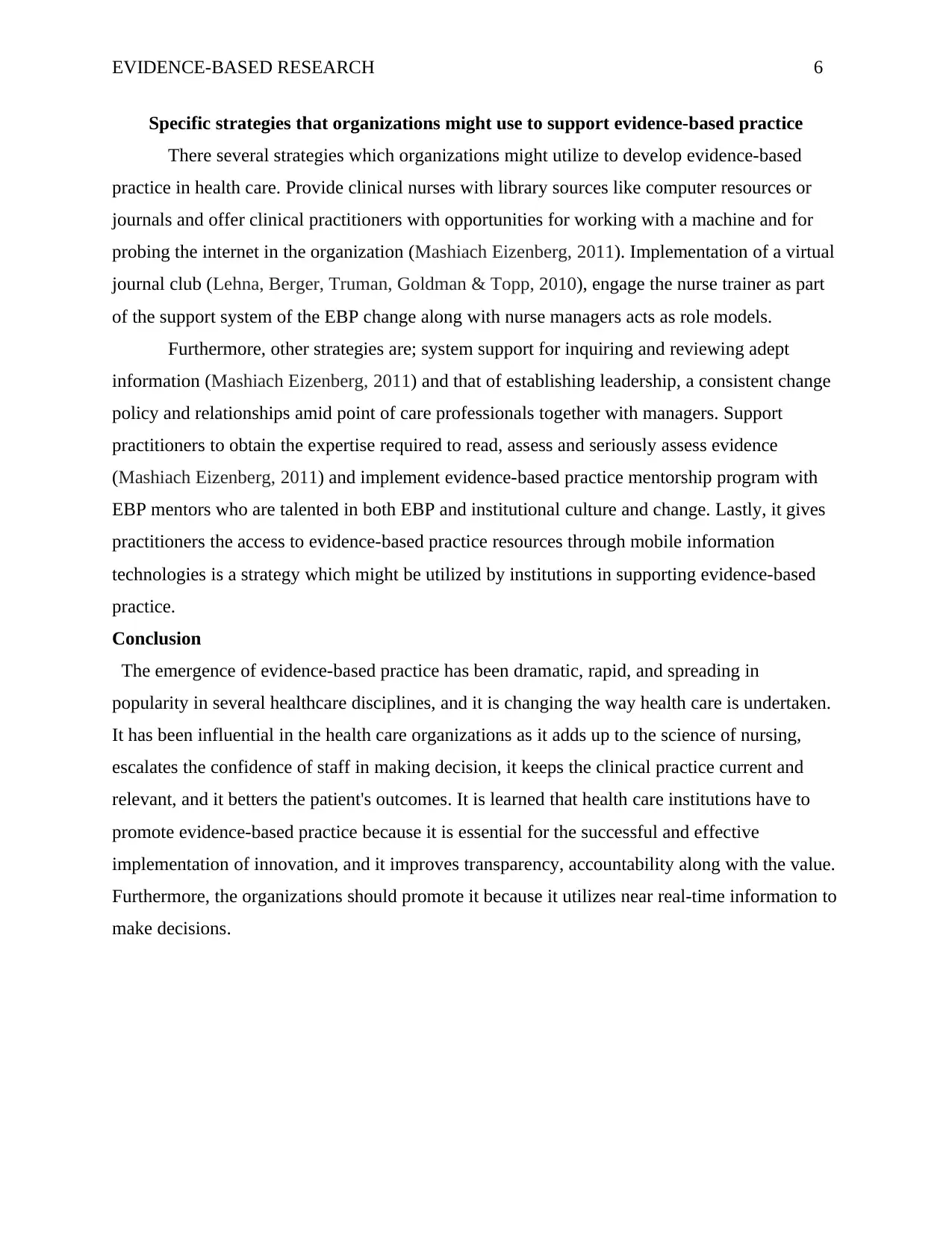
EVIDENCE-BASED RESEARCH 6
Specific strategies that organizations might use to support evidence-based practice
There several strategies which organizations might utilize to develop evidence-based
practice in health care. Provide clinical nurses with library sources like computer resources or
journals and offer clinical practitioners with opportunities for working with a machine and for
probing the internet in the organization (Mashiach Eizenberg, 2011). Implementation of a virtual
journal club (Lehna, Berger, Truman, Goldman & Topp, 2010), engage the nurse trainer as part
of the support system of the EBP change along with nurse managers acts as role models.
Furthermore, other strategies are; system support for inquiring and reviewing adept
information (Mashiach Eizenberg, 2011) and that of establishing leadership, a consistent change
policy and relationships amid point of care professionals together with managers. Support
practitioners to obtain the expertise required to read, assess and seriously assess evidence
(Mashiach Eizenberg, 2011) and implement evidence-based practice mentorship program with
EBP mentors who are talented in both EBP and institutional culture and change. Lastly, it gives
practitioners the access to evidence-based practice resources through mobile information
technologies is a strategy which might be utilized by institutions in supporting evidence-based
practice.
Conclusion
The emergence of evidence-based practice has been dramatic, rapid, and spreading in
popularity in several healthcare disciplines, and it is changing the way health care is undertaken.
It has been influential in the health care organizations as it adds up to the science of nursing,
escalates the confidence of staff in making decision, it keeps the clinical practice current and
relevant, and it betters the patient's outcomes. It is learned that health care institutions have to
promote evidence-based practice because it is essential for the successful and effective
implementation of innovation, and it improves transparency, accountability along with the value.
Furthermore, the organizations should promote it because it utilizes near real-time information to
make decisions.
Specific strategies that organizations might use to support evidence-based practice
There several strategies which organizations might utilize to develop evidence-based
practice in health care. Provide clinical nurses with library sources like computer resources or
journals and offer clinical practitioners with opportunities for working with a machine and for
probing the internet in the organization (Mashiach Eizenberg, 2011). Implementation of a virtual
journal club (Lehna, Berger, Truman, Goldman & Topp, 2010), engage the nurse trainer as part
of the support system of the EBP change along with nurse managers acts as role models.
Furthermore, other strategies are; system support for inquiring and reviewing adept
information (Mashiach Eizenberg, 2011) and that of establishing leadership, a consistent change
policy and relationships amid point of care professionals together with managers. Support
practitioners to obtain the expertise required to read, assess and seriously assess evidence
(Mashiach Eizenberg, 2011) and implement evidence-based practice mentorship program with
EBP mentors who are talented in both EBP and institutional culture and change. Lastly, it gives
practitioners the access to evidence-based practice resources through mobile information
technologies is a strategy which might be utilized by institutions in supporting evidence-based
practice.
Conclusion
The emergence of evidence-based practice has been dramatic, rapid, and spreading in
popularity in several healthcare disciplines, and it is changing the way health care is undertaken.
It has been influential in the health care organizations as it adds up to the science of nursing,
escalates the confidence of staff in making decision, it keeps the clinical practice current and
relevant, and it betters the patient's outcomes. It is learned that health care institutions have to
promote evidence-based practice because it is essential for the successful and effective
implementation of innovation, and it improves transparency, accountability along with the value.
Furthermore, the organizations should promote it because it utilizes near real-time information to
make decisions.
⊘ This is a preview!⊘
Do you want full access?
Subscribe today to unlock all pages.

Trusted by 1+ million students worldwide
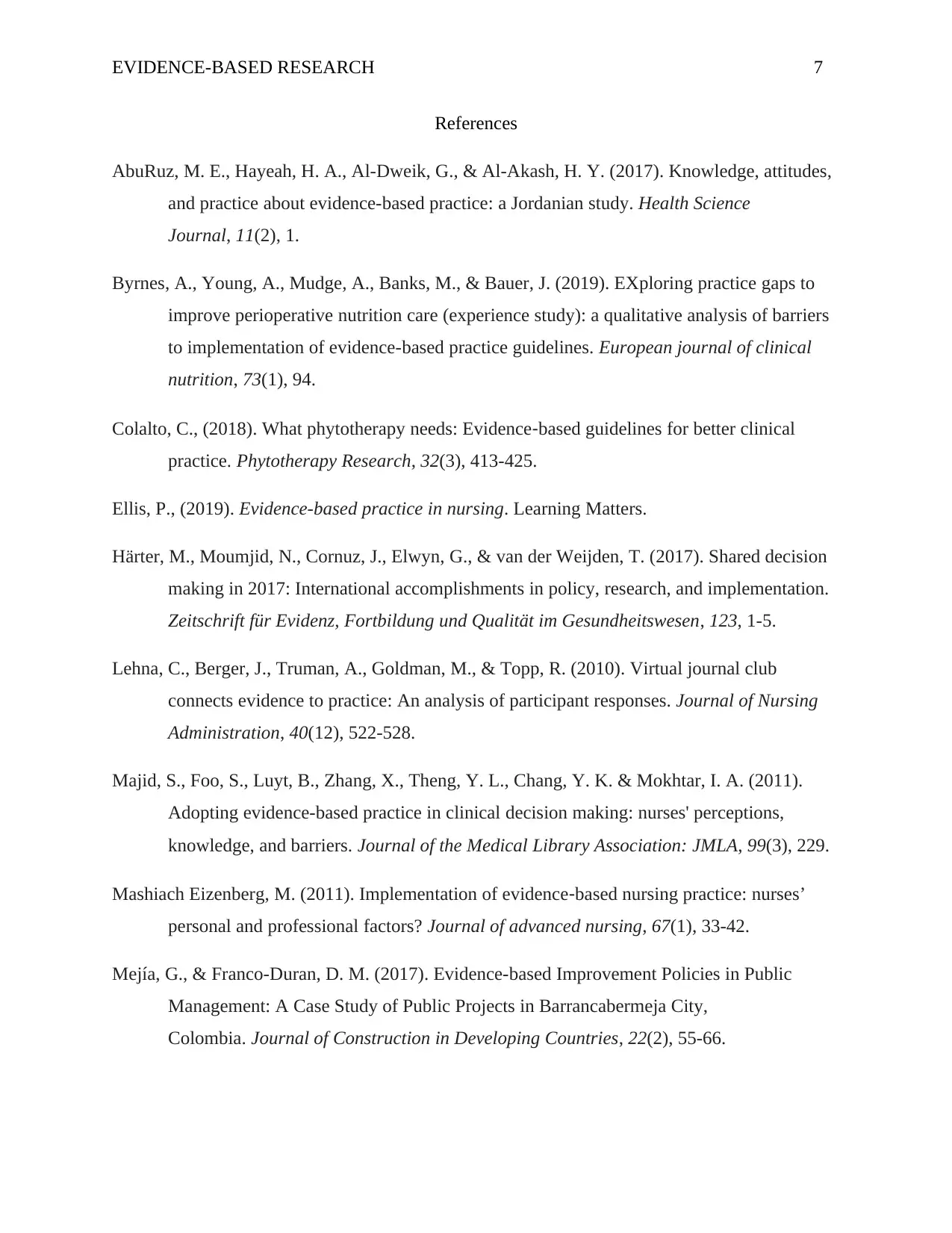
EVIDENCE-BASED RESEARCH 7
References
AbuRuz, M. E., Hayeah, H. A., Al-Dweik, G., & Al-Akash, H. Y. (2017). Knowledge, attitudes,
and practice about evidence-based practice: a Jordanian study. Health Science
Journal, 11(2), 1.
Byrnes, A., Young, A., Mudge, A., Banks, M., & Bauer, J. (2019). EXploring practice gaps to
improve perioperative nutrition care (experience study): a qualitative analysis of barriers
to implementation of evidence-based practice guidelines. European journal of clinical
nutrition, 73(1), 94.
Colalto, C., (2018). What phytotherapy needs: Evidence‐based guidelines for better clinical
practice. Phytotherapy Research, 32(3), 413-425.
Ellis, P., (2019). Evidence-based practice in nursing. Learning Matters.
Härter, M., Moumjid, N., Cornuz, J., Elwyn, G., & van der Weijden, T. (2017). Shared decision
making in 2017: International accomplishments in policy, research, and implementation.
Zeitschrift für Evidenz, Fortbildung und Qualität im Gesundheitswesen, 123, 1-5.
Lehna, C., Berger, J., Truman, A., Goldman, M., & Topp, R. (2010). Virtual journal club
connects evidence to practice: An analysis of participant responses. Journal of Nursing
Administration, 40(12), 522-528.
Majid, S., Foo, S., Luyt, B., Zhang, X., Theng, Y. L., Chang, Y. K. & Mokhtar, I. A. (2011).
Adopting evidence-based practice in clinical decision making: nurses' perceptions,
knowledge, and barriers. Journal of the Medical Library Association: JMLA, 99(3), 229.
Mashiach Eizenberg, M. (2011). Implementation of evidence‐based nursing practice: nurses’
personal and professional factors? Journal of advanced nursing, 67(1), 33-42.
Mejía, G., & Franco-Duran, D. M. (2017). Evidence-based Improvement Policies in Public
Management: A Case Study of Public Projects in Barrancabermeja City,
Colombia. Journal of Construction in Developing Countries, 22(2), 55-66.
References
AbuRuz, M. E., Hayeah, H. A., Al-Dweik, G., & Al-Akash, H. Y. (2017). Knowledge, attitudes,
and practice about evidence-based practice: a Jordanian study. Health Science
Journal, 11(2), 1.
Byrnes, A., Young, A., Mudge, A., Banks, M., & Bauer, J. (2019). EXploring practice gaps to
improve perioperative nutrition care (experience study): a qualitative analysis of barriers
to implementation of evidence-based practice guidelines. European journal of clinical
nutrition, 73(1), 94.
Colalto, C., (2018). What phytotherapy needs: Evidence‐based guidelines for better clinical
practice. Phytotherapy Research, 32(3), 413-425.
Ellis, P., (2019). Evidence-based practice in nursing. Learning Matters.
Härter, M., Moumjid, N., Cornuz, J., Elwyn, G., & van der Weijden, T. (2017). Shared decision
making in 2017: International accomplishments in policy, research, and implementation.
Zeitschrift für Evidenz, Fortbildung und Qualität im Gesundheitswesen, 123, 1-5.
Lehna, C., Berger, J., Truman, A., Goldman, M., & Topp, R. (2010). Virtual journal club
connects evidence to practice: An analysis of participant responses. Journal of Nursing
Administration, 40(12), 522-528.
Majid, S., Foo, S., Luyt, B., Zhang, X., Theng, Y. L., Chang, Y. K. & Mokhtar, I. A. (2011).
Adopting evidence-based practice in clinical decision making: nurses' perceptions,
knowledge, and barriers. Journal of the Medical Library Association: JMLA, 99(3), 229.
Mashiach Eizenberg, M. (2011). Implementation of evidence‐based nursing practice: nurses’
personal and professional factors? Journal of advanced nursing, 67(1), 33-42.
Mejía, G., & Franco-Duran, D. M. (2017). Evidence-based Improvement Policies in Public
Management: A Case Study of Public Projects in Barrancabermeja City,
Colombia. Journal of Construction in Developing Countries, 22(2), 55-66.
Paraphrase This Document
Need a fresh take? Get an instant paraphrase of this document with our AI Paraphraser
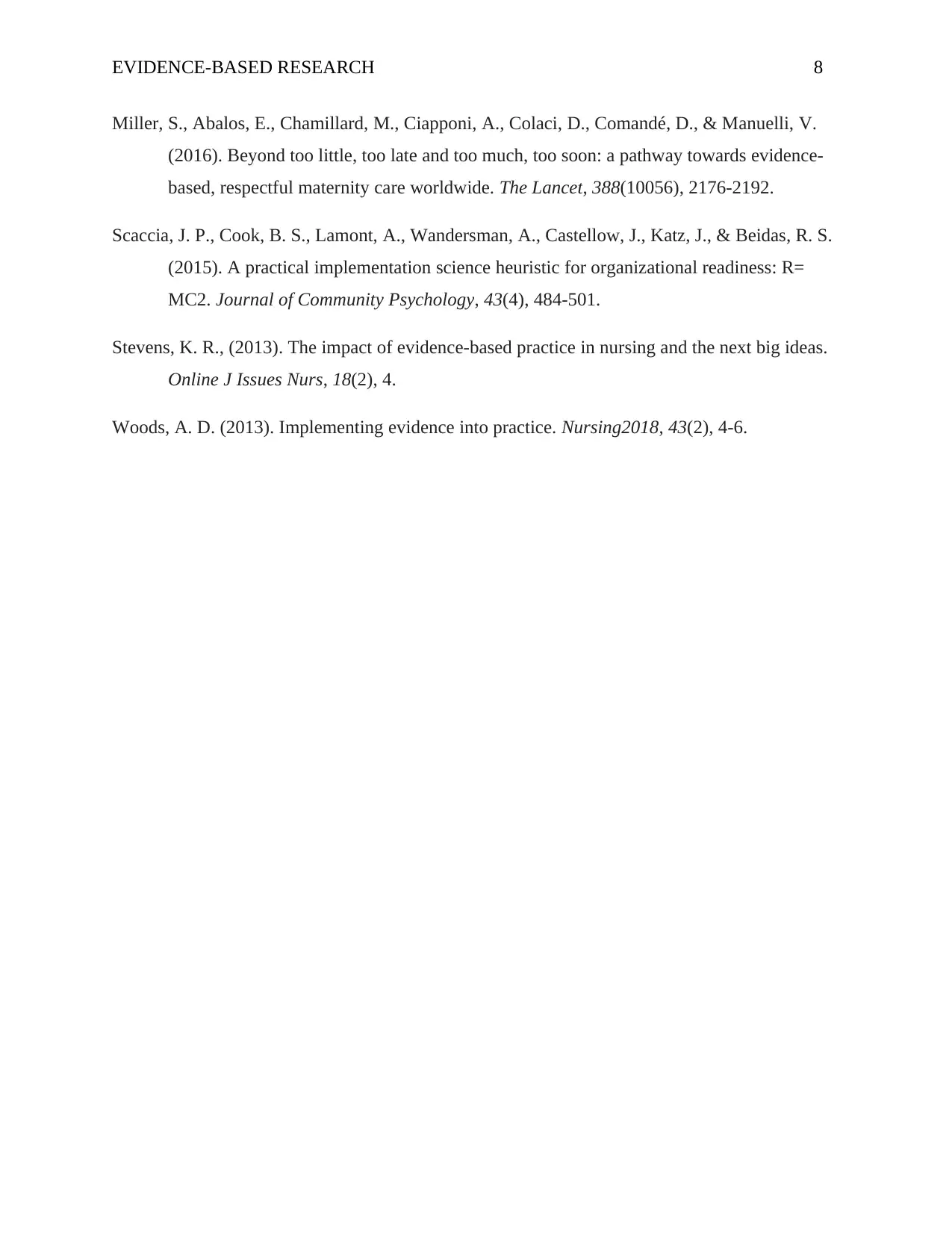
EVIDENCE-BASED RESEARCH 8
Miller, S., Abalos, E., Chamillard, M., Ciapponi, A., Colaci, D., Comandé, D., & Manuelli, V.
(2016). Beyond too little, too late and too much, too soon: a pathway towards evidence-
based, respectful maternity care worldwide. The Lancet, 388(10056), 2176-2192.
Scaccia, J. P., Cook, B. S., Lamont, A., Wandersman, A., Castellow, J., Katz, J., & Beidas, R. S.
(2015). A practical implementation science heuristic for organizational readiness: R=
MC2. Journal of Community Psychology, 43(4), 484-501.
Stevens, K. R., (2013). The impact of evidence-based practice in nursing and the next big ideas.
Online J Issues Nurs, 18(2), 4.
Woods, A. D. (2013). Implementing evidence into practice. Nursing2018, 43(2), 4-6.
Miller, S., Abalos, E., Chamillard, M., Ciapponi, A., Colaci, D., Comandé, D., & Manuelli, V.
(2016). Beyond too little, too late and too much, too soon: a pathway towards evidence-
based, respectful maternity care worldwide. The Lancet, 388(10056), 2176-2192.
Scaccia, J. P., Cook, B. S., Lamont, A., Wandersman, A., Castellow, J., Katz, J., & Beidas, R. S.
(2015). A practical implementation science heuristic for organizational readiness: R=
MC2. Journal of Community Psychology, 43(4), 484-501.
Stevens, K. R., (2013). The impact of evidence-based practice in nursing and the next big ideas.
Online J Issues Nurs, 18(2), 4.
Woods, A. D. (2013). Implementing evidence into practice. Nursing2018, 43(2), 4-6.
1 out of 8
Related Documents
Your All-in-One AI-Powered Toolkit for Academic Success.
+13062052269
info@desklib.com
Available 24*7 on WhatsApp / Email
![[object Object]](/_next/static/media/star-bottom.7253800d.svg)
Unlock your academic potential
Copyright © 2020–2025 A2Z Services. All Rights Reserved. Developed and managed by ZUCOL.





